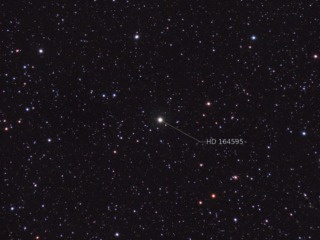
- Constellation: Sagittarius
- Right Ascension: 18h10m28.29s
- Declination: -27°29'59.0
On October 20th while doing sky patrol with his 180 mm lens, Koicho Itagaki from Japan discovered a "new" star in Sagittarius that wasn't there the previous time. The star, temporarily given the designation of TCP J18102829-2729590 until it's permanent name is assigned. The star then at 11th magnitude has since increased to 8th magnitude.
A classical nova is binary star system in which one of the members is a white dwarf. The white dwarf steals hydrogen from its companion star. The gas piles up on the white dwarf until it builds up enough density to ignite nuclear fusion. The layer ignites like a fusion bomb causing the star to brighten 50,000 to 100,000 times brighter with in hours. The star then slowly dims as it burns off the hydrogen fuel and the process of accretion of hydrogen gas begins again. The process can take anywhere from years to centuries.
Sagittarius is fertile hunting grounds for nova as it lies in the direction of the center of the Milky Way Galaxy.
The image was taken on the evening of October 27 with the ED80 refractor using R/G/B filters to create a color image. In addition a "V" band filter that only allows green light through was used to take a photometric observation of its brightness. Its brightness on that evening was computed at 8.234 magnitude.
- Details
- Category: Stars
- Telescope: EDT 80mm Reftactor

- Constellation: Andromeda
- Right Ascension: 01 04 35.54
- Declination: +41 17 57.8
RX And is a recurring dwarf nova star located in the constellation of Andromeda. Currently classified in the class of Z Camelopardalis variable stars, it consists of a white dwarf with an accretion disk siphoning matter from a secondary dwarf star. Once the accretion disk reaches a certain threshold, it becomes very bright until it can slowly cool back down. Usually this cycle takes from 10-13 days for RX And, but occasionally it gets stuck in a bright mode for periods for days to even years.
As part of an AAVSO optical monitoring campaign in support of Chandra X-Ray observations, I've been taking photometric measurements once a night. The star normally varies from as dim as 14.8 to as bright as 10.3 magnitudes. With a quick rise time in under 24 hours, sunscreen would be an essential item for anyone near this star system. My exposure times went from 480 seconds at its dimmest to 50 seconds near its brightest. All images were taken through a "V" filter which is a standard green band pass filter used for observations with the 80 mm refractor.
- Details
- Category: Stars
- Telescope: EDT 80mm Reftactor
- Camera: Atik 314l+

- Constellation: Hercules
- Right Ascension: 18h 00m 38.895
- Declination: +29° 34′ 18.92
- Distance: 92 ly
- Apparent Magnitude: 7
HD164595 is a G type star located in the constellation of Hercules. It is thought to have at least one planet roughly a mass of 16 times of Earth. It's claim to fame came in 2016 when a Russian team detected a signal from that area of the sky in 2015. No other signals have been detected. It is though what they found was a signal from a uncategorized Russian satellite. Maybe next time?
- Details
- Category: Stars
- Telescope: EDT 80mm Reftactor
- Camera: Atik 314l+

- Constellation: Sagittarius
Baade's window is area of lower amounts of interstellar gas and dust towards the nucleus of the Milky Way Galaxy. First noticed by Walter Baade, this area along with a few others offers a glimpse of the nucleus of our galaxy that is normally blocked by interstellar gas and dust.
- Details
- Category: Stars
- Telescope: EDT 80mm Reftactor
- Camera: Atik 314l+

- Constellation: Ophiuchus
- Right Ascension: 17h 57m 48.49803s
- Declination: +04° 41′ 36.2072"
- Distance: 6 ly
- Apparent Magnitude: 9.5
Barnard's Star is a low mass red dwarf star located in the constellation of Ophiuchus. It is an old star at an estimated age of 7 to 12 billions years of age. Red dwarfs such as this one can "burn" for a trillion years. Even at it's advanced age, it can produce flares, which are random, dramatic increases of brightness lasting many minutes.
Barnard's Star displays the highest proper motion of any of the stars due to its closeness at only 6 light years and its actual motion through space. It's movement is quite noticeable even at a years interval.
It's motion will bring it to within 3.75 light years distance from Earth at around 11,800 AD.
The animated image gif shows the motion over a two year span taken a few weeks ago, and summer two years ago.
- Details
- Category: Stars
Read more: Barnard's Star August 2016
- Telescope: EDT 80mm Reftactor
- Camera: Atik 314l+

- Constellation: Cygnus
- Right Ascension: 20h 06m 15.4527s
- Declination: +44° 27′ 24.791″
- Distance: 1,470 ly
- Apparent Magnitude: 11.7
KIC 8462852 is still in the news. KIC 8462852 is a F class star located in the constellation of Cygnus. At a magnitude 11.7, its only visible in telescopes, and is located some 1480 light years away. Often called Tabby's star after Tabetha Boyajian, the lead author on a paper investigating its unusual light curve. The star's unusual light curve was first discovered by citizen scientists as part of the Planet Hunters project examining data from the Kepler space telescope.
The light curve shows small random dips in brightness and a large dip in brightness in what appears to be around a 750 day cycle. The large dip can dim the star as much as 22%, which would take a very large object dimming almost half the star.
- Details
- Category: Stars
- Telescope: EDT 80mm Reftactor
- Camera: Atik 314l+